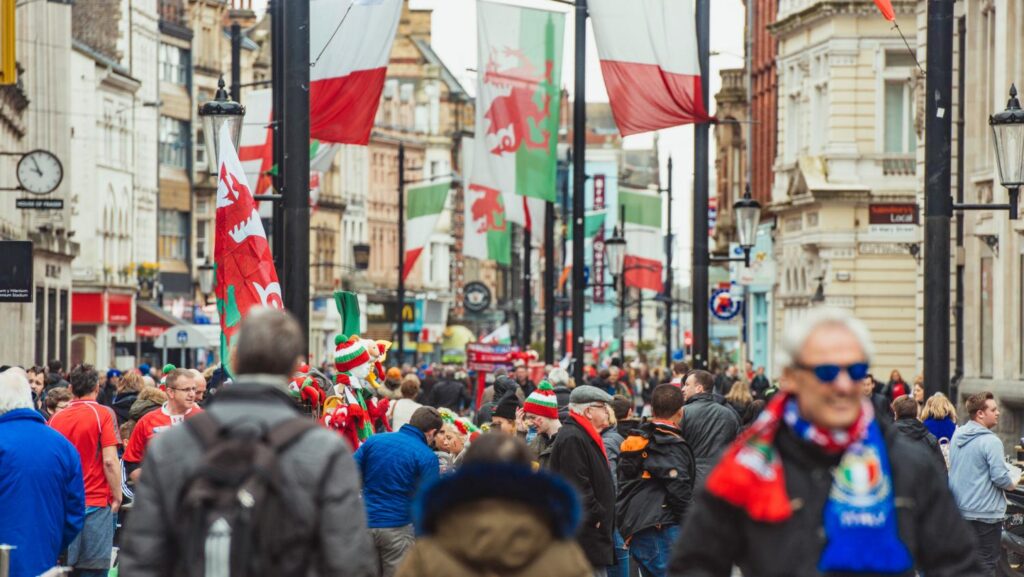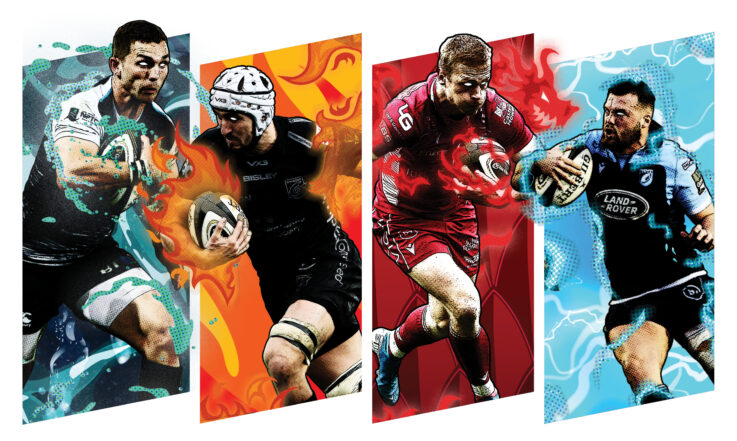The Story of Club and Regional Rugby in Wales
RUGBY UNION has traditionally been looked upon as the national sport of Wales and is undoubtedly considered a large part of the nation’s psyche and culture.
Match-days on the big occasions are a wonder to behold. Before and after the game, the streets and pubs are filled with people enjoying a carnival atmosphere of red jerseys, face paint, regular outbreaks of singing, beer, and the inevitable sprinkling of daffodil hats and inflatable sheep.
Writer and broadcaster Charles Williams describes rugby international weekends in Cardiff as “something very special to savour… it’s one of the world’s great sporting experiences, whether you’re going to the match, or just enjoying the atmosphere in the Welsh capital. There’s nowhere on earth like Cardiff on international rugby day.
“Yes, there are things which come close. We get pretty excited when our national football team is in town, or a boxing world title is at stake. It’s thrilling when Beyoncé or the Rolling Stones are rocking the city. But for a unique global, cultural experience, it has to be rugby, it has to be the Principality Stadium, and it has to be Cardiff. There’s really nothing like it.”

Inside the ground, the choral tradition of Wales manifests itself in singing at Wales games. Popular songs among the fans are Hymns and Arias by Max Boyce, Guide Me O Thou Great Redeemer (Bread of Heaven), Tom Jones’s Delilah, Cwm Rhondda and Calon Lan which, in part, replace the normal chanting of other rugby supporters. The pre-match singing of the Welsh national anthem – Hen Wlad Fy Nhadau – is utterly spine-tingling too.
The game itself is thought to have reached Wales in the 1850s, with the national body, the Welsh Rugby Union (WRU) being formed in 1881. It was taken up enthusiastically by Welsh working-class communities, both rural and industrial, with most towns and villages forming teams.
On the national stage, Wales would enjoy great periods of success, winning the most Five/Six Nations Championships, as well as reaching World Cup semi-finals in 1987, 2011 and 2019.
Older followers of the game consider the Wales team of the 1970s as the greatest of all time, but others argue that more modern successes have more than matched the achievements of that ‘Golden Era’.
The national team play at the WRU-owned Principality Stadium in the heart of Cardiff, and compete annually against England, Ireland, Scotland, Italy and France in the Six Nations Championship, plus the Rugby World Cup every four years. Wales has also enjoyed success in the abbreviated version of the game, winning the 2009 Rugby World Cup Sevens.
The main domestic competition in Wales is the Pro14 (historically, the Celtic League), in which Wales have four regional sides – Ospreys, Cardiff Blues, Scarlets and Dragons – in a competition which is also contested by Irish, Scottish and Italian teams.
In 2003/4, the WRU had voted to create five regions, but this soon became four when the Celtic Warriors were liquidated after just one season. Hopes have remained of developing a successful fifth region in north Wales.
The four Welsh regions also compete in the European Rugby Champions Cup and European Rugby Challenge Cup and alongside the teams of England’s Premiership in the Anglo-Welsh Cup.
Since 2013, the Principality Stadium has hosted ‘Judgement Day’, a double-header fixture involving all the Welsh regions. The first two editions had over 30,000 spectators. The 2015 edition had 52,762 spectators, the highest in the history of the league.

Beneath the Pro14, club rugby is represented by over 200 WRU affiliated clubs who play in the Welsh Premier Division and the lower Welsh divisional leagues.
Four Welsh teams compete in the British and Irish Cup, a competition for semi-professional and developmental sides from Great Britain and Ireland. They are usually the top Premier Division clubs of each region.
In recent years the women’s game has been flourishing and around 10,000 girls play rugby at school.
Historically, the four major clubs that have shaped the Welsh national team have been Cardiff, Newport, Swansea and Llanelli, though other clubs which have fought for prominence and provided national sporting heroes during the last 120-plus years include Bridgend, Neath, Pontypool, Pontypridd and England exiles London Welsh.
1947 saw the first unofficial club championship, won by Neath in its inaugural year, but dominated by Cardiff and Ebbw Vale until the 1960/61 season. In 1954, Welsh rugby sevens had their own tournament with the introduction of the Snelling Sevens competition, while the long-running Welsh Challenge Cup attracted not only income through sponsorship, but fervent following from supporters as David v Goliath match-ups caught the imagination right through to the showcase final.
In recent years, however, with professional rugby replacing the old amateur game at the top level, Welsh Premier Division and Welsh Championship club rugby has faced increased financial hardship, with historic clubs, which produced many legendary players for Wales down the years, under threat. Premiership side Neath RFC received a now-resolved winding-up petition from HM Revenue and Customs, while Championship team Pontypool RFC have had to fund-raise from supporters to remain at their ground.
The 1980s and early ’90s were a difficult time for the amateur game in Wales, with the national team suffering many defeats and harsh economic times that tempted high-profile players such as Jonathan Davies and Scott Gibbs to ‘go North’ to play professional rugby league in order to earn a living.
Whereas rugby in England fractured into the two separate sports of rugby union and rugby league over the issue of money, Wales for the most part stayed loyal to the union game. There were some attempts to run professional rugby league sides in Wales, but the heartland of Welsh rugby was simply too far from Yorkshire and Lancashire for this to be sustained.

There has traditionally been an element of class warfare to rugby union in Wales. In 1977, the pre-game pep talk attributed to Phil Bennett before facing England produced a memorable quote: “Look what these bastards have done to Wales. They’ve taken our coal, our water, our steel. They buy our homes and live in them for a fortnight every year. What have they given us? Absolutely nothing. We’ve been exploited, raped, controlled and punished by the English — and that’s who you are playing this afternoon.”
The Welsh valleys north of Cardiff produced so many quality number 10s that it was often referred to as The Outside-Half Factory immortalised in a song by Max Boyce. Boyce’s humour refers to rugby union very often and he has written many songs about the trials and tribulations of following the game as a fan.
The Outside-Half Factory
I’ll tell you a story,
’tis a strange and weird tale:
Of a factory in my valley,
not fed by road or rail.
It’s built beneath the mountain,
beneath the coal and clay.
It’s where we make the outside-halves,
that’ll play for Wales one day.
Down by the council houses,
where on a quiet day,
You can hear the giant engines
digging up the clay.
No naked lights or matches
where the raw material’s found
In the four-foot seams of outside-halves,
two miles below the ground.
We’ve camouflaged the mouth with stones,
from Bradford Northern spies:
/From plastic ‘E-Type’ Englishmen
with promise in their eyes.
And we’ve boarded up the entrance
for the way must not be shown;
And we’ll tell them all to **** off
and make their ****** own!
My Dad works down in arms and legs
where production’s running high.
It’s he that checks the wooden moulds
and stacks them forty high,
But he’s had some rejects lately,
‘cos there’s such a big demand;
So he sells them to the northern clubs,
and stamps them ‘second-hand’.
It’s there where Harry Dampers works,
it’s where the money’s best,
But now his health is failing
and the dust lies on his chest.
But he’ll get his compensation
though his health’s gone off the rails
When he sees that finished product
score the winning try for Wales.
But now the belts are empty,
came a sadness with the dawn.
And the body-press is idle,
and the valley’s blinds are drawn.
Disaster struck this morning
when a fitter’s mate named Ron
Cracked the mould of solid gold,
that once made Barry John.
Old Harry Dampers (struck with grief),
received the final call.
And old Harry has been taken to
the greatest outside-half of all.
Whose hands are kind and gentle,
though they bear the mark of nails,
So Harry stamped him ‘Number Ten’,
‘cos he was made in Wales.
And the wheels will go on turning,
and trams will run on rails,
To that factory ‘neath the mountain
making outside-halves for Wales.
BACK TO HOME PAGE